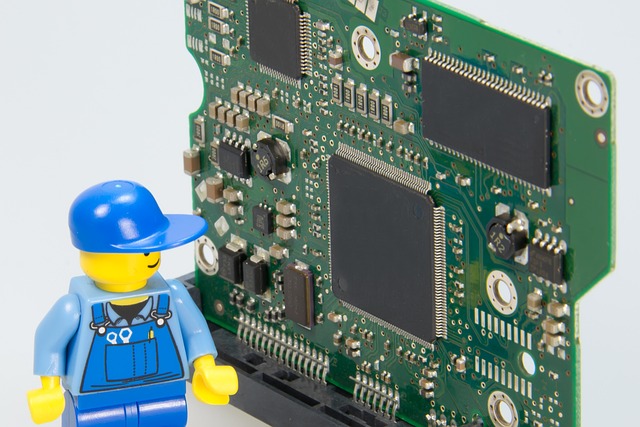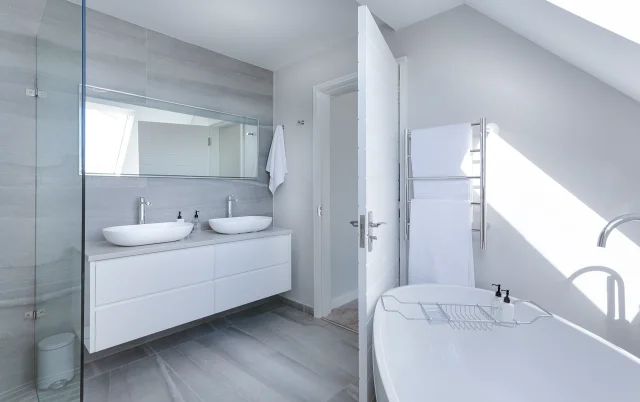How to vent a bathroom fan? A properly functioning bathroom fan is essential for maintaining a healthy and comfortable home environment. It removes excess moisture and odors, preventing mold growth and structural damage. This step-by-step guide will walk you through the essentials of proper venting techniques for your bathroom fan, from understanding the basics to professional installation, maintenance, and choosing the right fan for your needs. Whether you’re considering a DIY project or hiring a professional, this guide will help you decide to ensure your bathroom remains fresh and dry.
Contents
- 1 Understanding the Basics of Bathroom Venting
- 2 Professional Installation: Why It’s Essential
- 3 Maintenance and Upkeep of Your Bathroom Fan
- 4 Choosing the Right Bathroom Fan
- 5 DIY vs. Professional Help: Making the Right Choice
- 6 Conclusion
- 7 Frequently Asked Questions
- 7.1 Why is proper ducting important for bathroom fans?
- 7.2 What are the benefits of professional installation for bathroom exhaust fans?
- 7.3 How do modern bathroom exhaust fans enhance efficiency and convenience?
- 7.4 What should I do if my bathroom fan is leaking water?
- 7.5 When should I replace my bathroom fan?
- 7.6 Should I consider a DIY installation or hire a professional for my bathroom fan?
Key Takeaways
- Efficient bathroom venting relies on proper ducting to expel moist air outside, preventing mold and structural damage.
- Professional installation is critical for determining the correct fan size, placement, and ensuring safe electrical wiring.
- Regular maintenance, including cleaning and inspection, is essential for the longevity and efficiency of your bathroom fan.
- Choosing the right fan involves considering ceiling height, CFM requirements, and energy-efficient features.
- While DIY installations might seem cost-effective, the complexity of HVAC systems often necessitates hiring a professional.
Understanding the Basics of Bathroom Venting

The Role of Proper Ducting
Efficient venting is not just about the fan itself; it’s about the entire pathway the air travels. Proper ducting is essential to direct moist air outside, preventing it from causing mold and structural damage. A professional installer ensures that ductwork is correctly routed and sealed, which is crucial for the system’s effectiveness.
- Inspect the damper flap regularly to ensure it channels airflow correctly and prevents water intrusion.
- Check the vent cover for any signs of damage or blockage that could impede airflow.
Sealing and insulating the ducts in areas like crawl spaces can significantly improve the performance of your bathroom fan.
Remember, the goal is to maintain a balanced humidity level within your bathroom, which is a key factor in preventing long-term moisture issues.
The Mechanics of Exhaust Fans
Exhaust fans operate on a simple yet effective principle: a motor spins the fan blades, creating airflow that pulls moisture and odors out of the bathroom. The key to their functionality is the expulsion of air to the exterior, preventing humidity from accumulating and causing mold or structural damage.
Energy-efficient motors are a hallmark of modern exhaust fans, allowing for continuous operation without significantly impacting the energy bill. These motors balance performance with power consumption, making them a cost-effective solution for maintaining bathroom air quality.
- Proper ducting is essential to direct moist air out of the home.
- Humidity sensors and timers enhance fan efficiency and convenience.
- Improved blade design maximizes air movement and reduces noise.
Ensuring that the ductwork is correctly routed and sealed is crucial to prevent the recirculation of moist air or leaks into unintended areas.
Features to Enhance Efficiency and Convenience
Modern bathroom fans come with a variety of features designed to boost both efficiency and user convenience. Humidity sensors automatically activate the fan when moisture levels rise, preventing mold and mildew. Timers can be set to ensure the fan runs just long enough to be effective, conserving energy.
Noise level is a key consideration for comfort. Quieter fans are less intrusive and more likely to be used regularly. Some models offer a nightlight feature, providing soft illumination for those late-night visits without the need for bright overhead lights.
Ensuring your bathroom fan is equipped with the latest features can significantly enhance the overall bathroom experience.
Remember to prevent sewage smells by maintaining P-traps and vents. Regular cleaning, inspections, and proper ventilation are crucial to avoid health risks and maintain a fresh bathroom environment.
Professional Installation: Why It’s Essential
Correct Sizing and Placement
Correct sizing and placement of your bathroom fan are critical to its performance and efficiency. The fan should be powerful enough to exchange the air in your bathroom at least eight times per hour. This is where CFM, or cubic feet per minute, comes into play. It’s a measure of how much air the fan can move and is dependent on your bathroom’s size.
To determine the right CFM for your bathroom, you can use the following formula:
- Length x Width x Height = Cubic Feet
- Cubic Feet x 8 (air exchanges per hour) / 60 (minutes) = Required CFM
Placement is just as important as power. The fan should be located where steam and moisture are most prevalent, typically over the shower or bathtub.
Remember, a fan that’s too small won’t adequately ventilate the bathroom, leading to moisture and mold issues. Conversely, a fan that’s too large can be unnecessarily noisy and waste energy. Always consult with a professional to ensure that your fan meets both your needs and safety standards.
Safe Electrical Wiring
Ensuring the safety of your bathroom fan’s electrical wiring is not just a matter of following instructions; it’s about safeguarding your home from potential hazards. Certified electricians are crucial in this process, as they have the expertise to connect your fan to the home’s electrical system while adhering to stringent safety standards.
- Proper grounding and secure connections prevent electrical fires.
- Compliance with local codes avoids legal issues and ensures functionality.
- Regular checks for wire integrity can avert electrical failures.
The installation of your bathroom fan is not the place to cut corners. Safe electrical wiring is a fundamental aspect of a reliable and efficient bathroom ventilation system.
Remember, the risk of electrical hazards increases when non-professionals attempt to handle complex installations. It’s not just about getting the fan to work; it’s about making sure it works safely for years to come.
Compliance with Building Codes and Safety Standards
Ensuring your bathroom fan installation complies with local building codes and safety standards is not just a formality—it’s a necessity for the safety and legality of your home improvements. Certified technicians are crucial in this process, as they are familiar with the Electrical Code Requirements for bathrooms, such as the need for at least one permanently mounted light fixture.
Compliance isn’t only about following rules; it’s about guaranteeing the safety and efficiency of your bathroom fan for years to come.
When hiring a professional, verify their knowledge of the International Energy Conservation Code (IECC) and their ability to conduct air leakage testing, which is required for new construction energy compliance. A well-installed bathroom exhaust fan should include testing and venting to the outdoors, ensuring that moisture and odors are properly expelled from your home.
Remember, safe electrical wiring is paramount. Certified electricians will make sure that your fan’s installation meets all necessary standards, significantly reducing the risk of electrical hazards.
Maintenance and Upkeep of Your Bathroom Fan

Regular Cleaning and Inspection
Regular cleaning is crucial for maintaining your bathroom fan’s performance. Turn off the power at the circuit breaker before you begin. Remove the fan cover and use a vacuum with a brush attachment to clean the blades. Wipe the cover with a damp cloth before reattaching it.
Inspection is equally important. Annually check the exterior vent and duct for obstructions like bird nests or debris. Ensure the vent flap is not stuck and can move freely.
Consistent maintenance not only ensures efficient operation but also extends the life of your bathroom fan.
Remember to inspect and clean the fan’s filter every three months to prevent buildup that can hinder airflow and efficiency. If your system includes additional features like a humidity sensor or timer, check these periodically to ensure they are functioning correctly.
Diagnosing and Fixing Leaky Fans
Leaky bathroom fans can lead to water damage and mold growth. Identifying the cause is the first step to a solution.
Condensation is a common culprit, especially in colder months. Warm air from showers hits cold ducts, leading to water droplets that can drip back down.
Here’s a quick guide to diagnose and address leaks:
- Check for condensation in the ductwork after a hot shower.
- Inspect the fan for any visible damage or obstructions.
- Ensure the duct is properly insulated to prevent future condensation.
Quick action is crucial to prevent extensive damage. If you’re unsure, consider hiring a professional to avoid complications.
While some issues can be fixed DIY, complex problems may require an expert. Remember, the HVAC system is delicate; a professional can ensure repairs are done correctly.
When to Replace Your Bathroom Fan
Knowing when to replace your bathroom fan is crucial for maintaining a healthy and moisture-free bathroom environment. Most bathroom fans have a life expectancy of five to ten years. As they age, their efficiency in removing moisture decreases, which can lead to problems like mold and water damage.
It’s advisable to replace your fan if you notice it’s not performing as well as it once did, to prevent it from failing completely.
If you’re unsure about the condition of your fan or if it’s leaking, it’s best to consult with a licensed electrician. Dealing with electrical equipment in wet conditions can be dangerous and is not recommended for DIY repairs. Additionally, if there’s already mold growth or other water damage, professional help may be required to address these issues.
Here’s a quick checklist to help you decide if it’s time for a replacement:
- The fan is older than 5 years
- Decreased efficiency in moisture removal
- Presence of mold or water stains
- Unusual noises or vibrations
- The fan is leaking
Remember, while some manufacturers offer easy installation solutions, professional installation ensures safety and optimal performance.
Choosing the Right Bathroom Fan

Ceiling Height and CFM Requirements
When selecting a bathroom fan, the Ceiling Height and CFM (cubic feet per minute) are critical factors to consider. The Home Ventilating Institute (HVI) suggests 1 CFM per square foot for bathrooms under 100 square feet. For ceilings higher than 8 feet, adjust the CFM to compensate for the additional air volume.
For larger bathrooms, the calculation changes:
- Add 50 CFM for each toilet, shower, or bathtub
- Add 100 CFM for a jetted tub
Ensure your fan’s capacity matches your bathroom’s size and features for optimal moisture and odor control.
Remember, a fan too small won’t effectively remove moisture, while an oversized fan can waste energy. Use the following table to guide your choice:
| Bathroom Size (sq ft) | Base CFM Requirement | +Toilet/Shower/Bathtub | +Jetted Tub |
|---|---|---|---|
| Under 100 | 1 CFM per sq ft | +50 CFM each | N/A |
| 100 and above | Calculate volume | +50 CFM each | +100 CFM |
Proper sizing ensures efficiency and longevity of your bathroom fan, contributing to a comfortable and healthy home environment.
Features for Enhanced Functionality
When selecting a bathroom fan, enhanced functionality can significantly improve user experience and performance. Look for features that simplify operation and maintenance, such as humidity sensors, motion detectors, and built-in timers. These smart additions can lead to energy savings and increased longevity of the fan.
Humidity sensors automatically activate the fan when moisture levels rise, preventing mold and mildew growth. Motion detectors ensure the fan is only in use when the bathroom is occupied, while timers can be set to run the fan for a specific duration after the bathroom is vacated, ensuring complete moisture removal.
Consider the integration of these features:
- Humidity sensors for moisture control
- Motion detectors for occupancy-based operation
- Timers for post-use exhaust
- Quiet operation for minimal noise disruption
- Easy access panels for quick cleaning
By investing in a bathroom fan with advanced features, you not only enhance the bathroom environment but also contribute to the overall efficiency of your home’s ventilation system.
Energy Efficiency Considerations
In the pursuit of a greener home, energy efficiency is a key factor in selecting a bathroom fan. Modern exhaust fans are not only about ventilation; they are also about sustainability and reducing energy bills.
Energy-efficient models often come with higher upfront costs but can lead to significant savings over time. Look for the ENERGY STAR certification to ensure you’re getting a product that meets strict energy performance standards.
- Lower Energy Consumption: Energy-efficient fans use less power.
- Cost Savings: Reduced energy bills over the fan’s lifespan.
- Rebates and Incentives: Utility companies may offer financial incentives.
Remember, investing in an energy-efficient bathroom fan is not just a personal benefit; it’s a step towards a more sustainable future.
DIY vs. Professional Help: Making the Right Choice

Understanding the Complexity of HVAC Systems
HVAC systems are more than just a collection of equipment; they are intricate networks that require a deep understanding of airflow, temperature control, and air quality. Properly balancing these elements is crucial for creating a comfortable and safe home environment.
- Airflow dynamics
- Temperature consistency
- Air quality management
Italics are used to emphasize the importance of each aspect, underscoring the complexity of HVAC systems. A DIY approach may overlook these subtleties, leading to inefficient operation and potential discomfort.
The complexity of HVAC systems extends beyond the equipment. It encompasses the entire home ecosystem, demanding a holistic approach to ensure optimal performance.
Understanding the HVAC system is essential before attempting any DIY projects. This knowledge is not just about following a guide on DIY carpet cleaning for homeowners, but about grasping the intricacies of your home’s heating, ventilation, and air conditioning.
The Risks of DIY Electrical Work
Electrical safety is paramount when installing bathroom fans. DIY attempts can lead to improper connections, risking shocks and fires. Certified electricians are trained to adhere to local codes, ensuring a hazard-free setup.
Incorrect installation not only poses immediate dangers but may also result in long-term issues that can be costly to rectify.
- Voided Warranties: Attempting a DIY install might invalidate your fan’s warranty.
- Complex Systems: HVAC systems are intricate, with specific requirements for safe operation.
- Potential for Damage: Mistakes can lead to further damage, requiring more extensive repairs.
Remember, the cost of professional installation is a worthwhile investment in your safety and peace of mind.
Benefits of Hiring a Professional Installer
Opting for a professional installer for your bathroom fan is not just a matter of convenience; it’s a strategic decision for long-term benefits. Professionals ensure optimal performance and adherence to safety standards, which is crucial for such an integral part of your home’s ventilation system.
Warranty Preservation is a significant advantage of professional installation. Many manufacturers stipulate that a certified installer must carry out the installation to maintain the warranty. This means that any DIY attempt could potentially void your warranty, leaving you unprotected against defects.
- Accurate sizing and placement
- Safe and compliant electrical wiring
- Expertise in HVAC systems
Professional installation sets the foundation for your fan’s efficiency and longevity, while also preserving the manufacturer’s warranty.
Remember, a well-installed fan contributes to Maximizing Indoor Air Quality and comfort, which are key benefits of a properly functioning bathroom exhaust system.
Conclusion
In conclusion, ensuring that your bathroom fan is properly vented is a critical aspect of maintaining a healthy and comfortable home environment. From selecting the right fan with appropriate features to professional installation and regular maintenance, each step plays a vital role in effective moisture and odor control.
Remember to consider the specifics of your bathroom, such as ceiling height and the local climate, to tailor the venting techniques to your needs. While some tasks may seem manageable as DIY projects, the importance of professional expertise cannot be overstated, especially when it comes to electrical safety and adherence to building codes. By following the guidance provided in this step-by-step guide, you can extend the life of your bathroom fan, prevent mold and structural damage, and ensure a well-ventilated space for years to come.
Frequently Asked Questions
Why is proper ducting important for bathroom fans?
Proper ducting is crucial for efficient venting, as it ensures moist air is directed outside your home, preventing recirculation or leaks into attic spaces or walls, which could cause mold and structural damage.
What are the benefits of professional installation for bathroom exhaust fans?
Professional installation ensures correct sizing and placement of the fan for effective moisture and odor removal, safe electrical wiring, and compliance with building codes and safety standards.
How do modern bathroom exhaust fans enhance efficiency and convenience?
Modern exhaust fans may include features like humidity sensors that activate the fan when moisture levels rise, or timers to ensure the fan runs for an adequate duration.
What should I do if my bathroom fan is leaking water?
Leaky fans may indicate duct condensation. This can happen when warm bathroom air cools in colder areas, causing condensation that drips back down. Professional inspection and repair are recommended.
When should I replace my bathroom fan?
Most bathroom fans last between five and ten years. Replace your fan when it shows signs of inefficiency or reaches the end of its lifespan to ensure your bathroom remains moisture-free.
Should I consider a DIY installation or hire a professional for my bathroom fan?
Due to the complexity and potential risks of HVAC systems and electrical work, it is usually best to hire a professional installer to ensure the job is done safely and correctly.


